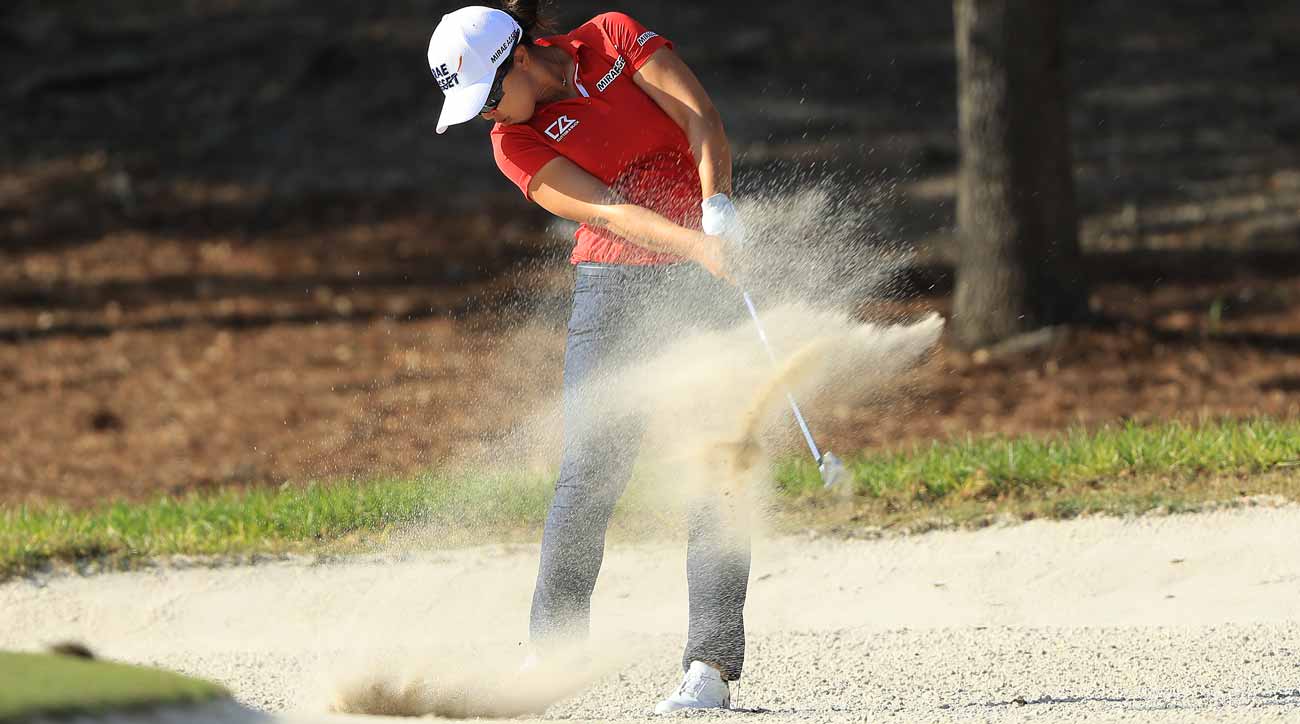The top 10 ways to be a better bunker player
BY: KELLIE STENZEL, TOP 100 TEACHER OCTOBER 11, 2020

Greenside sand shots seem to instill fear is so many, and I can relate. The wide variety of different bad shots can range from barely advancing the ball to thining the ball so far that you may have to yell “fore” at golfers on the green. This wide variety, I believe, is why so many golfers are scared of these shots. Here are some concepts you need to understand and apply to turn your bunker game into an asset in your arsenal, and boost your consistency.

1. Stop listening to bad advice
This was me when I was in college, playing on the team at Furman University, I struggled with my green side sand so much that I would ask anyone and everyone for advice. The theory of the day wouldn’t work and then once again, I would lose my confidence and search again for the next “answer.” I now understand, as an instructor, that I was being given advice that wasn’t appropriate for me, a female golfer who did not have male tour golfer swing speed. Since most golfers do not fall into the male PGA Tour player, the technique used in the bunker needs to match the speed and characteristics of the golfer.
An example of this would be opening the club face in the green side sand. While this might be great advice for Bryson DeChambeau, who oozes speed, but for the medium-to-lower clubhead speed golfer it may be a disaster as it will make the golf ball travel shorter and if that particular golfer, when they take sand the ball does not go far enough, opening the club face would make them worse. This is one example of many. Your bunker technique need to be tailored to you! So stop listening to any and all advice and work to understand what works for you.
2. Practice throwing sand onto the green
In order to be a good greenside sand player you need to be willing to take sand and a fair amount of it. I like to see a long divot. The club should enter the sand before the ball, stay in the sand moving across the sand and then exit well after the ball. This scraping motion will allow the loft of the club to elevate the golf ball. You DO NOT need to try to lift the ball of the sand, but believe me, I understand this inclination. Simply practicing throwing the sand out of the bunker with your sand wedge and onto the grass is a great way to practice this proper motion. I greatly improved my own bunker game, by first understanding cause and effect, but secondarily practicing throwing sand and shells out of the practice bunker where I was teaching at the time. By taking the ball out of the equation, I learned the right motion and then transferred this to my on course play. Getting good at hitting sand will help you to avoid the skulled shot where the ball goes flying or catches the lip and comes back to you. It can also be helpful to understand the the loft of your sand wedge is plenty to clear most bunker lips. You do not need to do anything fancy, but to take the sand and let the loft do the lift.

3. Generate momentum
Once you get very good at taking sand, adding speed is necessary to throw the sand and the ball forward and to the target. I often say the order is as important if not more important than the content of the information I teach. If you don’t take sand, I could never convince you to add speed. The important thing to remember is not to swing short and hard; you want the speed to be the product of your golf swing. You want to use the momentum of the golf club to generate the speed that you need. The good news is that if you take sand and do not have a large enough swing or enough speed the ball will not go very far and your natural reaction would be to add swing size and speed and in this case be correct. I feel that the speed I swing with my green side sand shots is most of the time the same speed as my regular full golf swing.
4. Good ball position and setup
Your ball position being forward in your stance is extremely important so that your club head will enter the sand before the golf ball. By placing the ball forward of center, when the club hits the sand relatively centered in your stance, it will help it to hit the sand first. A centered ball position will often cause the club to hit the ball first and the ball will go flying way over the green. You may see good players twist their feet in the sand and there is a good reason for this. When you dig your feet into the sand, so that the soles of your shoes disappear, this lowers the bottom of your swing, which also makes it that much easier to take sand.

5. Use the bounce as designed
If there is a “secret” to good bunker play, it is understanding how the bottom of your lob, sand and gap wedge have a design factor called bounce which makes it glide through the sand, rather than dig and get stuck. Your club face needs to be square or slightly open so that you can use the bounce properly. Higher speed swings can open the face to help limit distance and increase the bounce and glide. Lower club head speeds should keep the face square. Often there is some type of writing on the grip and shaft of the club to tell you when it is sitting properly. Lofted clubs, by design are lofted and can look open. The shaft at impact needs to be straight up and down or leaning back and away from the target. A club shaft that leans forward toward the target can offsets the bounce of the club and produce a digging club head that just gets stuck. Once again your set up is a big part of this. With your ball position forward in your stance, your club handle should still be centered in your body so that it points to your center. This helps to maintain loft and bounce.
6. Adjust your setup so you swing across the ball
The challenge and the fun of green side sand is that compared to all other golf skills there are so many different ways to be successful….but in order for it to work consistently it has to be tailored to swing motion and swing speed. Slicers of the golf ball are often good bunker players and those who tend to hook the ball struggle. An open face works well here because it glides and a closed face digs. Therefore, setups need to be adjusted for those who hook the ball. Your bunker play needs to be personalized and that takes a trained professional. If you struggle, take a lesson from the best bunker instructor you can find and it will make a world of difference.

7. Learn to control your distances
Once you are set up will with your ball position forward, your feet dug into the sand, holding your club full length, you need to understand that there are three ways you can control the distance of your bunker shots. Experiment with each of them and use them to your advantage.
1. Club selection
If you learn one basic set up and swing you can control distance by simply changing clubs. The more lofted the club the shorter the ball will travel. Your lob wedge (58-60 degrees) for your shortest shots, your sand wedge (56-54 degrees) for your medium shots and your gap wedge (50-52 degrees) for your longer green side sand shots.
2. Swing pace
The pace of your swing can also control distance. Slower for shorter, medium for middle distances and faster for longer distances. The farther your proper the sand the farther the ball will travel.
3. Swing path
Your swing path can also help to control distance. The farther you want your ball to travel, the more you will want to make your full swing back swing where you turn your torso and have a circular swing. This curve and turn helps to shallow the path, and create more power, speed and distance. If you are lucky enough to have high club head speed you can make a backswing in the sand that is relatively straight back, where you don’t turn and this path will cause less speed and allow the ball to travel a shorter distance.
8. Understand your release
Your bunker swing should be much more like your pitching than your full swing due to the fact that it is so important to avoid the club shaft leaning too much toward the target so that your club can glide and not dig. And while it starts with a good set up, feeling the proper release where the club head is allowed to release so that it lines up with the shaft at impact. I describe this as feeling as if your trail hand is “slapping” at the bottom to allow the bounce of the club to work properly, while either maintaining or increasing loft. If you are able to make the proper bunker release this will allow the club to glide through the sand due to the lower profile face due to the loft.

9. Know your max distances
When you do take sand with your gap wedge in a relatively full swing, how far can your golf ball travel when hit properly? This is important to know. Once you know this distance, then you will be able to make a educated decision on when to change to a fairway bunker technique, where contact of the club is made with the ball before the sand enabling more distance.
10. Remember the golden rule for fairway bunkers
Now that you understand when to transition from green side bunker technique to a fairway bunker shot because you understand how far your gap wedge travels when you take sand. When you need more distance out of the bunker you should change your set up and technique to help you to make contact with the ball before the sand. The first priority is to select a club that has enough loft to clear the lip of the bunker in front of you. Yet up to allow you to make contact with he ball first before the sand and the simplest way to do this is to change your ball position in your stance to more centered to maybe even slightly back. You can experiment to see what ball position works best for you. It can also be helpful to narrow your stance slightly and even grip down just a bit on the handle of the club club. The more narrow stance will help to minimize body motion and make better contact with the ball first and the send.
I love teaching green side sand because I can completely relate to the struggle that it took for me to understand and have success. You need to have a technique that is tailored to your own golf game inclusive of your speed, swing and club face. Apply the understanding and technique that matches you and find a little time to practice and build confidence. Getting out of the sand and onto the green can be a good start, but once you own this, start to advance to distance control. When you have basic fundamentals you will tend not to get into as many bunkers as you have more earned confidence.
Originally posted on Golf.com
